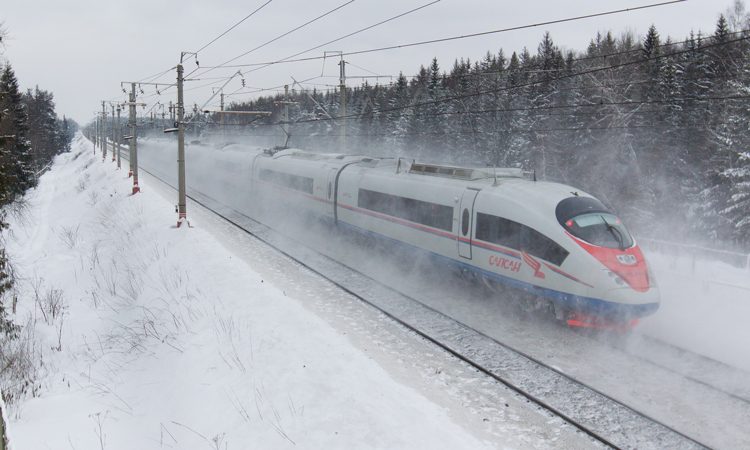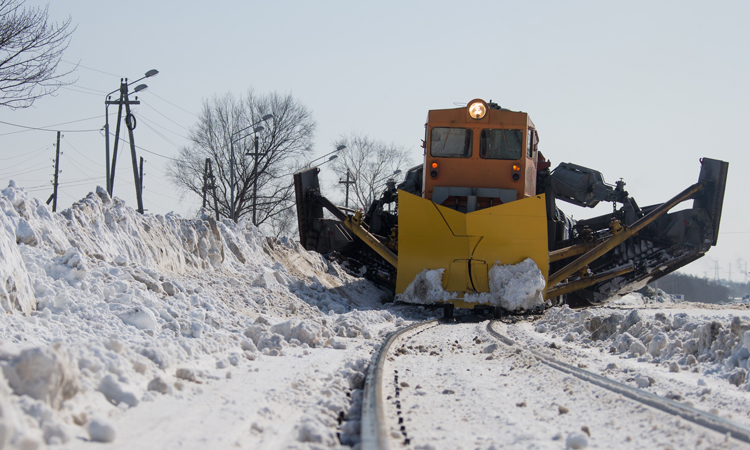Keeping Russia’s railways moving during winter
Posted: 4 November 2016 | Gennady Verkhovykh | No comments yet
The seasons can impact our transport systems and its infrastructure, which – by extension – affect our daily lives. By far the most problematic weather conditions descend in winter, however, and this is especially true for northern Europe and Russia. In this article Gennady Verkhovykh, Senior Vice-President and Head of the Central Directorate of Infrastructure of JSC Russian Railways, divulges the annual housekeeping activities that help to assure the smooth running of Russia’s railways during the harsh winter months.


Winter in Russia lasts from 1 November to 31 March. In a country with such a vast territory, regional climates vary greatly and winter arrives at different times. Snow and blizzards appear earliest for the railways of the Urals, Siberia, the Russian Far East and the northernmost parts of the Northern and October Railway lines.
It’s no secret that the Russian winter is snowy and harsh. Railways in Russia are divided into several groups according to the degree of snowfall, i.e., the blizzard and snow intensity observed on the railway during the winter.
The West Siberian Railway
The West Siberian Railway is classed as having ‘very heavy snowfall’ and Sverdlovsk, South Ural, Kuibyshev, Krasnoyarsk, Northern (above the latitude of Syktyvkar station), and October (above the latitude of Belomorsk station) railways are classed as ‘heavy snowfall’, faced with snowfalls of strong intensity (20cm of snow over no more than 12h) and blizzards with strong intensity (wind speed of at least 15m/s and meteorological visibility of no more than 500m for at least 12h).


A number of snowploughs are deployed along the railways to clear tracks of snow and ice
East Siberia, the Russian Far East and Gorky railways, as well as the southern areas of the Northern and October Railways, are classified as areas of ‘snowfall’.
Southeastern, Volga, Moscow, the North Caucasus, and Kaliningrad railways are classified with ‘average snowfall’ and the Zabaikalskaya Railway – within which snowfalls and blizzards have a mild intensity – is classified as having ‘weak snowfall’.
The railroad tracks are protected from snow drifts on platforms and stations with the help of protective forests, as well as the permanent snow-barrier fences and portable snow shield applications. Each year before 1 November, on railway sections affected by snow, switchboards are repaired and manufactured; permanent snow-barrier fences are repaired; and new snow-barrier devices are constructed.
JSC Russian Railways begins its winter preparations long before the first snow falls. In the middle of summer in every region, responsible leaders are appointed to coordinate the first preparations for infrastructure and rolling stock for operation at low temperatures; then combat snow drifts and generally ensure that trains can move uninterrupted thereafter. The railways have developed an anti-snow plan for major stations and includes the alignment of snowploughs and snow-removal equipment. Workers are provided with the necessary winter clothing and footwear.
The main instrument of control for preparing the Russian Railways for the approaching winter is the automated Zima system. This system records data on the content of technical equipment, logistics, staffing, training, and provision of protective clothing. Analytical data makes it possible to quickly make management decisions for one property or another.


The winter in Russia can be snowy and harsh; an anti-snow plan is carried out to ensure the railways are kept moving
Before the onset of winter, it is necessary to check the following: The state of lighting stations; open spaces of railway facilities (station tracks, crossings, etc.); the proper functioning of snowploughs and snow-removal technology; and technical service buildings and structures. At all stations of JSC Russian Railways pneumatic blasting compressor devices for getting rid of snow must be checked, electric heating of turnouts assessed, and the state of warning systems for people working on the tracks must be assured.
Heating areas for workers employed to remove snow are also prepared, with particular attention being paid to extensively training employees who will work for the first time on the railway during the winter.
Power-generation facilities are checked first including the overhead lines, traction substations, energy and power devices, signalling devices, centralisation and blocking devices, and the power supply of vital facilities (boilers, water intakes, etc.). It is necessary for repair work at these facilities to be completed by 1 November.
The state of the boiler and thermal networks that provide heat and water in the holding is also reviewed.


Russian Railways delpoys snow-removal machinery when heavy snowfall occurs and the railways need to be cleared efficiently and effectively
In winter the efforts of all railway employees are focused on ensuring the uninterrupted movement of both freight and passenger trains.
Any trees and bushes that could potentially fall onto the railway track, the overhead lines, or wires and cables must be cleared.
In areas where ice can potentially form on cables, a system that preventively heats the line and keeps melting ice from short-circuiting currents is turned on. In addition, a network of railway locomotives is used to combat snow and ice. They are equipped with vibrating pantographs for clearing ice from the cable and wire brushes to clean the decking crossings. All of these devices also undergo compulsory testing before winter begins.
Along the railway lines, snowploughs of various designs are used, one or more at a time, for simultaneously cleaning single-track and multi-path zones. If snow is less than one-metre-deep and low in density, clearing can be completed in a single pass. Snow is removed from the path in the direction of the slope embankment. Also, a control is set to keep supports for the overhead lines and signalling devices from being damaged when snowploughs are in use.
Snow is cleared at stations by trains made up of snow-removal machines and cars and is unloaded in special places set aside for snow dumps approved by regional supervisory authorities. It must be removed to places far from water bodies so they are not contaminated by uncleaned melt water.
In addition to the cleaning of passenger platforms of snow and ice, a normal temperature is maintained in the premises of railway stations and industrial premises. Heating systems on the train carriages are checked and the winter ventilation mode is set; the serviceability of the electric composting toilets is also tested. During the winter months, passenger wagons with faulty heating system are excluded from trains.


Potential avalanches areas along stretches of railway are closely monitored and regularly inspected
Avalanche areas are under special control at this time of year. Avalanches may occur in locations extending along forestless sections of slopes of 20° to 60° and a height of 10m above the railhead. Such sites are closely monitored and, at the onset of the avalanche period, are regularly inspected. If necessary, with the help of specialised organisations, artificial snow avalanches are initiated. The timely construction and maintenance of anti-avalanche facilities plays a major role in ensuring the safe and uninterrupted movement of trains during this period.
In the design and construction of new railway lines, the main method of eliminating avalanche danger is to create a system of engineering works to keep snow avalanches from affecting railway tracks.
The most dangerous sites are located in the Russian Far East at the borders of the Russian Far East and East Siberian Railway (Lena–Khani), Sakhalin (Shakhta–Kholmsk), and in Southern Siberia at the borders of the Krasnoyarsk Railroad (Mezhdurechensk–Biskamzha).
In order to timely inform employees of the expected severe weather, JSC Russian Railways has a Department of Hydrometeorology and geophysical stations. By analysing all kinds of meteorological information, experts develop a specialised weather forecast. In the event of severe weather events, an alert storm-warning goes off for all enterprises of the holding. The storm-warning transmits data about the expected time and place it will take place on a particular section of the railway, indicating the quantitative characteristics of the phenomenon (wind speed, intensity and duration, etc.).
Daily meteorological observations are conducted in the danger period. In potentially hazardous areas, using stratigraphic studies, drilling pits assess the state of the snow layer. Experts from special avalanche research stations perform daily patrols along the main routes; from specially equipped areas they evaluate the avalanche hazard. Afterwards, all the data is processed and analysed and an opinion regarding the avalanche situation is issued.
JSC Russian Railways has gained vast experience in the construction and operation of railways in different climatic conditions. Today we can say with certainty that only through timely preparation for work in the winter can we ensure the uninterrupted movement of trains and provide customers with a high level of service.
Biography










